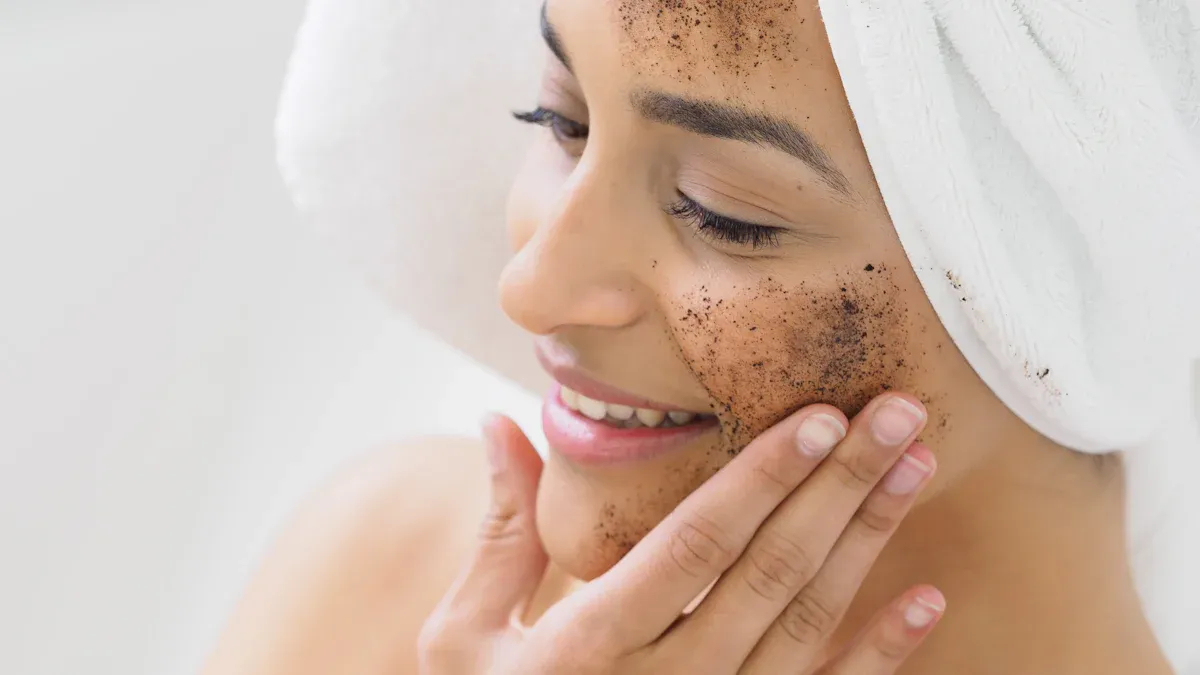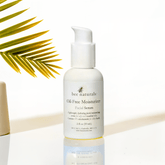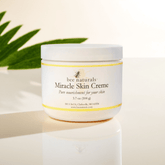How to Achieve Radiant Skin with Mechanical, Chemical, and Enzymatic Exfoliation in 2025

Radiant skin starts with proper care, and exfoliation—whether mechanical, chemical, or enzymatic—is key to achieving it. Exfoliation removes old skin cells, revealing a fresh, glowing layer underneath. Selecting the right method is essential, as each type of exfoliation works differently. Mechanical exfoliation involves tools or scrubs to physically clean the skin, while chemical exfoliation uses acids to dissolve dead cells. Enzymatic exfoliation, on the other hand, relies on natural enzymes for a gentler approach.
Your skin type plays a crucial role in determining whether mechanical, chemical, or enzymatic exfoliation is best for you. Choosing the right method helps prevent irritation and ensures effective results. Incorporating exfoliation into your skincare routine can significantly enhance your skin’s appearance.
Key Takeaways
Exfoliation helps your skin glow. It clears away old skin cells and shows new skin.
Pick the right exfoliation for your skin type: scrubs for normal skin, acids for oily skin, and gentle enzymes for sensitive skin.
Exfoliate 1 to 3 times weekly. Doing it too much can hurt your skin and make it red.
After exfoliating, use lotion and sunscreen. This keeps your skin soft and safe.
Watch how your skin reacts. Change your routine if your skin feels bad.
What is Exfoliation and Why It Matters?
Definition and Purpose of Exfoliation
Exfoliation means getting rid of dead skin cells. These cells sit on the top layer of your skin. As you grow older, your skin sheds these cells more slowly. This can make your skin look dull and rough. Exfoliating helps your skin stay fresh and smooth. You can use mechanical, chemical, or enzymatic methods to exfoliate. The goal is always the same: to keep your skin healthy and glowing.
Exfoliation does many helpful things. It clears out clogged pores and boosts blood flow. It also helps your skin absorb products better. These benefits make your skin look brighter and healthier. Studies show that exfoliation can even increase collagen. Collagen keeps your skin firm and elastic.
Benefits of Exfoliation for Skin Health
Exfoliation does more than just remove dead skin cells. It makes your skin feel softer, fights acne, and keeps it hydrated. For example:
Glycolic acid, a common chemical exfoliant, removes dead cells and oil. It also helps your skin make more collagen.
It raises hyaluronic acid levels, which keeps your skin moist and smooth.
Research shows it protects your skin from UVB rays, reducing sun damage.
Exfoliation also helps your skin repair itself. It activates important cells that help your skin heal and stay strong. Adding exfoliation to your routine helps your skin renew itself and stay healthy over time.
Why Exfoliation is Essential for Radiant Skin
Healthy, glowing skin starts with good care, and exfoliation is a big part of that. It removes dead skin cells to show the fresh layer underneath. This keeps your skin smooth and even. Without exfoliation, your skin can get dry, flaky, and irritated.
Using a gentle exfoliator a few times a week is helpful. But exfoliating too much can harm your skin. Over-exfoliation can cause redness, irritation, and dryness. Your skin might even get patchy or break out.
By exfoliating carefully, you avoid these problems and improve your skincare routine. Whether you like mechanical, chemical, or enzymatic exfoliation, doing it the right way helps your skin look its best.
Types of Exfoliation

Exfoliation is an important part of skincare. Knowing the different types helps you pick the best one. The three main types—mechanical, chemical, and enzymatic—work in unique ways to clear dead skin cells. This process makes your skin smoother and healthier.
Mechanical Exfoliation
Mechanical exfoliation uses scrubbing to clean off dead skin cells. Tools like brushes, sponges, or scrubs are often used. Scrubs may contain sugar, salt, or tiny beads to gently polish skin.
This method improves skin texture and reduces rough spots. It also helps fade fine lines and boosts collagen. Collagen keeps skin firm and helps it repair itself. Mechanical exfoliation speeds up cell turnover, revealing fresh skin for a glowing look.
Tip: Use soft scrubs and gentle pressure to avoid irritation. Scrubbing too hard can cause redness or sensitivity. Limit this method to once or twice weekly.
Chemical Exfoliation
Chemical exfoliation uses acids to loosen dead skin cells. Ingredients like glycolic acid, salicylic acid, and lactic acid are common. These acids target issues like acne, uneven tone, or dull skin.
This method has many benefits. Glycolic acid removes dead cells and increases collagen, keeping skin smooth. It also shrinks large pores and helps skin absorb moisturizers better. Chemical exfoliation works deeper in the skin for lasting results.
Note: Start with low acid levels if you're new to this. Always wear sunscreen after, as skin becomes more sensitive to sunlight.
Enzymatic Exfoliation
Enzymatic exfoliation uses natural fruit enzymes to clean skin. Papaya, pineapple, and pumpkin enzymes break down dead skin proteins. This method doesn’t need scrubbing or strong chemicals.
It’s great for sensitive or easily irritated skin. Enzymatic exfoliation works gently on the surface, avoiding redness or discomfort. It leaves skin soft and refreshed while keeping its natural balance.
Did you know? Enzymatic exfoliation is ideal for dry or delicate skin. It’s a mild way to get glowing skin without irritation.
Learning about mechanical, chemical, and enzymatic exfoliation helps you choose the right one. Each type offers special benefits for smoother, healthier skin in 2025.
How to Choose the Right Exfoliation Method
Matching Exfoliation Methods to Skin Types
Your skin type decides the best exfoliation method for you. Oily or acne-prone skin benefits from chemical exfoliation. Ingredients like salicylic acid clear pores and reduce acne. For dry or sensitive skin, enzymatic exfoliation is gentle and safe. It removes dead cells without causing irritation. Normal or combination skin works well with mechanical exfoliation. A soft scrub smooths rough areas and improves skin texture.
Tip: Test new exfoliation products on a small patch of skin first. This helps avoid bad reactions.
Addressing Specific Skin Concerns
Exfoliation helps with many skin problems. Chemical exfoliation brightens dull skin by removing dead cells. It also encourages skin renewal. Mechanical exfoliation smooths rough or uneven skin. Enzymatic exfoliation calms redness and irritation. It works gently and leaves skin feeling fresh.
Knowing how often to exfoliate is important. Most people should exfoliate one to three times weekly. Too much exfoliation can damage your skin’s barrier.
Considering Personal Preferences and Lifestyle
Your preferences and lifestyle affect your exfoliation choice. Chemical exfoliants like glycolic acid are quick and easy to use. Mechanical exfoliation with a scrub or brush feels like a spa treatment. Enzymatic exfoliation is great if you like natural ingredients. It uses fruit enzymes from papaya or pineapple.
Note: Being consistent matters more than exfoliating often. Regular exfoliation keeps skin healthy and boosts your skincare routine.
How to Exfoliate Safely and Effectively
Preparing Your Skin for Exfoliation
Getting ready helps exfoliation work well and safely. First, wash your face with a gentle cleanser and warm water. This clears dirt and oil, stopping irritation during exfoliation. Pick an exfoliant that suits your skin type. For sensitive skin, use mild options like enzyme-based products or gentle acids like mandelic or lactic acid.
Don’t press too hard when exfoliating. Soft motions keep your skin safe. If using chemical exfoliants, follow the directions carefully. Start slow to avoid irritating your skin. After exfoliating, always apply moisturizer. This helps repair your skin’s barrier and keeps it hydrated.
Using Mechanical Exfoliants Properly
Mechanical exfoliation uses scrubs or tools to remove dead skin. Choose scrubs with tiny grains or soft brushes. Avoid rough scrubs with big particles, as they can harm your skin. Use the scrub on damp skin with light, circular motions. Focus on rough spots like elbows or knees, but don’t scrub too much.
Only exfoliate once or twice a week. Doing it too often can cause redness or make your skin sensitive. For legs, use a gentle scrub and moisturize after to keep them smooth and soft.
Applying Chemical Exfoliants Effectively
Chemical exfoliation uses acids to break down dead skin cells. Begin with a low-strength acid like glycolic or salicylic acid, especially if you’re new to it. Spread the product evenly on clean, dry skin. Stay away from sensitive areas like your eyes and lips.
Always read and follow the product’s instructions. Some chemical exfoliants stay on your skin, while others need rinsing after a set time. Wear sunscreen daily after using chemical exfoliants. This protects your skin from sunlight and keeps it healthy.
Tip: Unsure how often to exfoliate? Start with once weekly and adjust based on how your skin reacts.
Best practices for enzymatic exfoliation
Enzymatic exfoliation gently removes dead skin cells while keeping skin healthy. Follow these simple steps for the best results:
Start with a clean face: Wash your face with a gentle cleanser. This removes dirt and oil, helping the enzymes work better.
Apply the enzyme product carefully: Spread a thin layer of the product evenly on your skin. Avoid areas like your eyes and lips to prevent irritation.
Relax and let it work: Leave the product on your skin for the suggested time. A slight tingle is normal as the enzymes break down dead cells.
Rinse and neutralize: Wash off the product gently with warm water. Use a soft towel to pat your skin dry.
Finish with hydration: Use a moisturizer or serum to keep your skin hydrated and protected.
Products like the Sisley Paris Exfoliating Enzyme Mask and DMK enzyme therapy are great for refreshing your skin. These products not only remove dead cells but also improve blood flow and boost collagen. This leaves your skin glowing and smooth.
Tip: Use enzymatic exfoliation one or two times weekly. Doing it too often can irritate your skin, so stick to a regular but gentle routine.
Post-exfoliation care and hydration
After exfoliating, your skin needs extra care to stay soft and healthy. Proper care helps repair your skin and prevents dryness or irritation.
Hydrate immediately: Use a moisturizer with ingredients like hyaluronic acid or ceramides. This keeps your skin moist and calm.
Protect with SPF: Exfoliation makes your skin more sensitive to sunlight. Apply sunscreen with SPF 30 or higher to protect it from UV rays.
Avoid harsh products: Skip strong acids, retinoids, or alcohol-based toners for a day or two. These can irritate your freshly exfoliated skin.
Focus on gentle care: Use mild cleansers and soothing serums to help your skin recover.
Studies show that combining lactic acid with urea improves skin texture and moisture. For example, a formula with 5% lactic acid and 10% urea reduced keratosis pilaris symptoms by 55%. Also, 93% of people in a study said their skin felt smoother after 16 weeks of regular hydration care.
Note: Keeping your skin hydrated is very important after exfoliating. Always moisturize and protect your skin after every session.
Common Mistakes to Avoid When Exfoliating
Over-exfoliation and its effects
Exfoliating too much can hurt your skin. It removes the protective layer, making skin sensitive and irritated. This is worse for sensitive skin, where scrubs can cause redness. Using too many chemical exfoliants can dry out your skin and cause breakouts.
Experts say to exfoliate only once or twice a week. This gives your skin time to heal and stay healthy. Scrubbing too hard with physical exfoliators can make irritation last longer. Overusing acids like AHAs or BHAs can also weaken your skin. Pay attention to your skin—if it feels sore or red, stop exfoliating for a while.
Choosing the wrong products for your skin
Using the wrong exfoliator can harm your skin. Different skin types need different products. Oily skin works well with salicylic acid, while dry skin prefers enzymatic exfoliation. Harsh scrubs on delicate skin can cause peeling and redness.
Pick products that match your skin type. If unsure, start with a gentle option and test it on a small spot. Watch how your skin reacts. The right product removes dead cells without causing harm or irritation.
Neglecting aftercare and sun protection
Exfoliating makes your skin fresh but also more delicate. Aftercare is very important. Always use a moisturizer after exfoliating to keep your skin hydrated. Look for ingredients like hyaluronic acid or ceramides to lock in moisture.
Protect your skin from the sun too. Freshly exfoliated skin is more sensitive to sunlight, which can cause dark spots or damage. Use sunscreen with SPF 30 or higher to keep your skin safe. Avoid strong products like retinoids for a day or two after exfoliating. Gentle care helps your skin heal and stay glowing.
Tip: Taking care of your skin after exfoliating keeps it healthy and radiant.
Exfoliation is an important part of keeping skin healthy. Mechanical, chemical, and enzymatic methods each help in different ways. Learn how to exfoliate and pick the right method for your skin. This helps solve skin problems better. Try these methods to find what suits you best. Doing it regularly keeps your skin soft and bright. Always use the right steps and care after exfoliating to protect your skin. With the right routine, glowing skin in 2025 is possible!
Tip: Go slow and pay attention to your skin’s needs for great results.
FAQ
What is the best exfoliation method for sensitive skin?
Enzymatic exfoliation is ideal for sensitive skin. It uses fruit enzymes to gently remove dead skin cells. This method avoids irritation and keeps your skin calm and balanced.
How often should you exfoliate your skin?
Exfoliate about one to three times a week. Doing it too much can damage your skin’s protective layer. Watch how your skin reacts and adjust how often you exfoliate.
Can exfoliation help with acne?
Yes, exfoliation helps with acne. Chemical exfoliants like salicylic acid clean out clogged pores and reduce oil. This lowers breakouts and makes your skin smoother over time.
Should you exfoliate before or after cleansing?
Always exfoliate after washing your face. Cleansing removes dirt and oil first. This helps the exfoliant work better and reduces the chance of irritation.
Is sunscreen necessary after exfoliating?
Yes, sunscreen is very important after exfoliating. Exfoliation makes your skin more sensitive to sunlight. Use sunscreen with SPF 30 or higher to protect your skin from sun damage.




